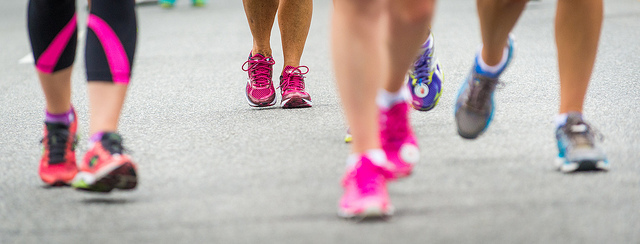Running Principles

A slew of running injuries have been arriving at the clinic recently and I have found myself educating clients on efficient running mechanics. So, I thought it would be a good time to revisit a blog on running.
Is there an optimal running technique?
Should we all run the same way considering there are vast differences in the level of runners, the distance of running and our own biomechanical and physiological properties. I believe and promote economical running by educating clients on a few simple principles and letting individuals LEARN to run naturally.
Economical running principles:
- Foot Strike Type: Are you a forefoot, midfoot or heel striker? Essentially, what part of your shoe contacts the ground first is how you would answer this question. Research shows that there is increased in forces applied to your joints for heel strikers. Think of landing on your heels after you jump up. To soften the impact, you would naturally land on your midfoot or forefoot. But excessive forefoot impact increases the load on your achilles tendon and calf system which could lead to achilles tendon and calf injuries. So, a midfoot strike somewhere between the heel and the ball of your foot is the preferred point of contact in my opinion. I know its not very specific but it allows for natural tendency to prevail.
- Foot Strike location: Another component of your foot strike that impacts your running is the location of contact. WHERE your foot strikes rather than HOW. The further your foot strikes in front of your center of gravity (COG), the more likely your heel strikes first. This forward placed impact will create a braking force that opposes your forward motion, regardless of the type of foot strike. Your goal in running is to maximize the forward motion of your COG safely and efficiently. Learning to place your foot contact beneath your COG will not only increase your efficiency but also promotes a mid-foot strike.
- Cadence (steps you take per minute): Your cadence or how often your feet contact the ground should be around 180 foot-strikes per minute. Studies consistently show that majority of elite long distance runners run at this rate. A low cadence will promote over striding/reaching as the runner attempts to cover as much ground as they can per step. As mentioned before, over reaching will increase the braking force applied to your forward motion and promote heel-striking. I also see a higher vertical displacement in runners with low cadence resulting in a bounding or bouncing type running style. Your goal is to move forward, not up and down.You can calculate your cadence by counting the number of times one foot contacts the ground for a specific interval. So, your right (or left) foot should hit the ground 90 times in a 60 second interval or 45 times in 30 seconds. For those individuals who are accustomed to over-striding, this will feel like you are shuffling your feet at this cadence because you will need to shorten your stride length. Don’t worry, you will get used to it. Those who run to music, do a quick internet search ‘180 BPM running music’ to find a playlist of appropriate songs to run to.
I hope these simple principles can help you establish efficient and safe running mechanics. Of course there are many more variables that affect your running mechanics and can lead to injuries. If you are having issues reaching your running goals, a health care practitioner at PhysioWorks would love to help you achieve your goals. Book in for a running gait analysis with a comprehensive physiotherapy assessment to start your recovery.
Rob Iwasaki, BScPT, BScKin, Clinical STOTT Pilates, CAFCI

About twice a month our therapists will be posting answers to commonly asked questions. So, if you have a burning question that you want answered let us know in the comments below.
We can cover anything ranging from active rehabilitation, to injury prevention.
This week our featured therapist is Rob Iwasaki. To learn more about Rob check out our PhysioWorks team.


Leave a Reply